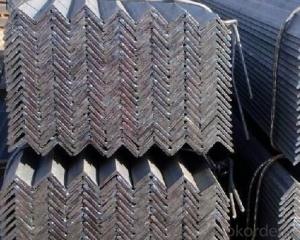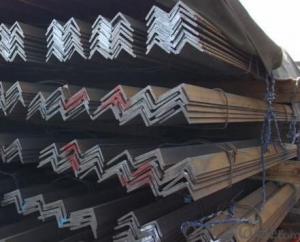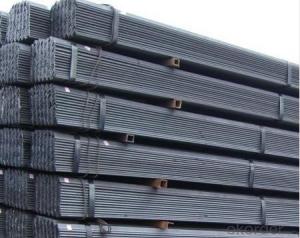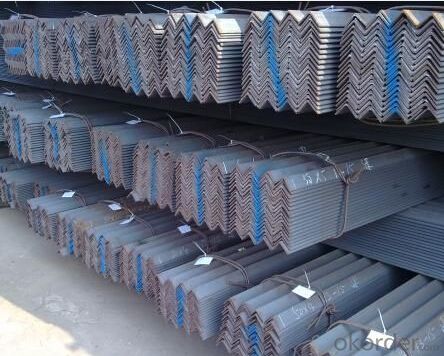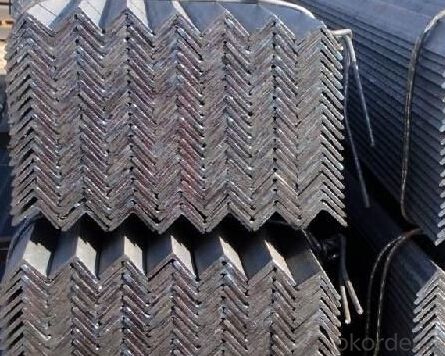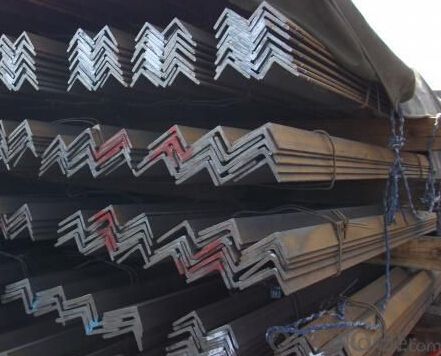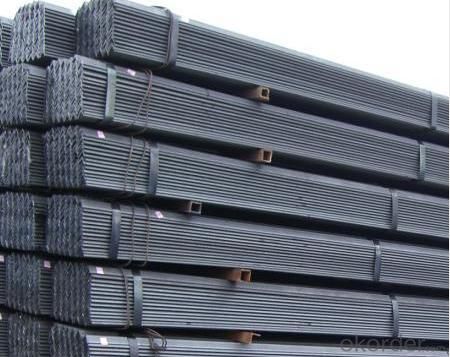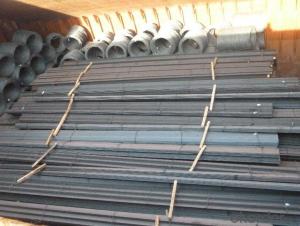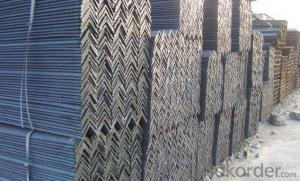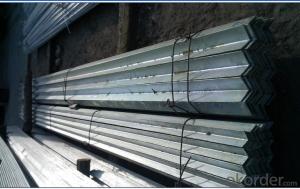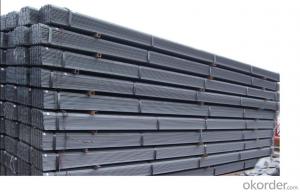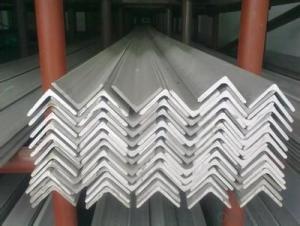Angle Steel with Material: GB Q235B, Q345B or Equivalent; ASTM A36; EN 10025, S235JR, S355JR; JIS G3192
- Loading Port:
- China main port
- Payment Terms:
- TT or LC
- Min Order Qty:
- 100 m.t.
- Supply Capability:
- 5000 m.t./month
OKorder Service Pledge
OKorder Financial Service
You Might Also Like
Product Description:
OKorder is offering Angle Steel with Material: GB Q235B, Q345B or Equivalent; ASTM A36; EN 10025, S235JR, S355JR; JIS G3192 at great prices with worldwide shipping. Our supplier is a world-class manufacturer of steel, with our products utilized the world over. OKorder annually supplies products to European, North American and Asian markets. We provide quotations within 24 hours of receiving an inquiry and guarantee competitive prices.
Product Applications:
Angle Steel with Material: GB Q235B, Q345B or Equivalent; ASTM A36; EN 10025, S235JR, S355JR; JIS G3192 are ideal for structural applications and are widely used in the construction of buildings and bridges, and the manufacturing, petrochemical, and transportation industries.
Product Advantages:
OKorder's Angle Steel with Material: GB Q235B, Q345B or Equivalent; ASTM A36; EN 10025, S235JR, S355JR; JIS G3192 are durable, strong, and resist corrosion.
Main Product Features:
· Premium quality
· Prompt delivery & seaworthy packing (30 days after receiving deposit)
· Corrosion resistance
· Can be recycled and reused
· Mill test certification
· Professional Service
· Competitive pricing
Product Specifications:
1 Standards: GB,ASTM,BS,AISI,DIN,JIS
2. Invoicing on theoretical weight or actual weight as customer request
3. Material:Material: GB Q235B, Q345B or Equivalent; ASTM A36; EN 10025, S235JR, S355JR; JIS G3192, SS400; SS540.
4. Size:
Sizes: 25mm-250mm | ||
a*t | ||
25*2.5-4.0 | 70*6.0-9.0 | 130*9.0-15 |
30*2.5-6.6 | 75*6.0-9.0 | 140*10-14 |
36*3.0-5.0 | 80*5.0-10 | 150*10-20 |
38*2.3-6.0 | 90*7.0-10 | 160*10-16 |
40*3.0-5.0 | 100*6.0-12 | 175*12-15 |
45*4.0-6.0 | 110*8.0-10 | 180*12-18 |
50*4.0-6.0 | 120*6.0-15 | 200*14-25 |
60*4.0-8.0 | 125*8.0-14 | 250*25 |
5. Material details:
Alloy No | Grade | Element (%) | |||||
C | Mn | S | P | Si | |||
|
|
|
|
|
|
| |
Q235 | B | 0.12—0.20 | 0.3—0.7 | ≤0.045 | ≤0.045 | ≤0.3 | |
|
|
|
|
|
|
| |
Alloy No | Grade | Yielding strength point( Mpa) | |||||
Thickness (mm) | |||||||
≤16 | >16--40 | >40--60 | >60--100 | ||||
≥ | |||||||
|
|
|
|
|
| ||
Q235 | B | 235 | 225 | 215 | 205 | ||
Alloy No | Grade | Tensile strength (Mpa) | Elongation after fracture (%) | ||||
Thickness (mm) | |||||||
| ≤16 | >16--40 | >40--60 | >60--100 | |||
≥ | |||||||
|
|
|
|
|
|
| |
Q235 | B | 375--500 | 26 | 25 | 24 | 23 | |
Usage & Applications of GB Q235 Angle Steel
Trusses;
Transmission towers;
Telecommunication towers;
Bracing for general structures;
Stiffeners in structural use.
Packaging & Delivery of GB Q235 Angle Steel
1. Transportation: the goods are delivered by truck from mill to loading port, the maximum quantity can be loaded is around 40MTs by each truck. If the order quantity cannot reach the full truck loaded, the transportation cost per ton will be little higher than full load.
2. With bundles and load in 20 feet/40 feet container, or by bulk cargo, also we could do as customer's request.
3. Marks:
Color mark: There will be color marking on both end of the bundle for the cargo delivered by bulk vessel. That makes it easily to distinguish at the destination port.
Tag mark: There will be tag mark tied up on the bundles. The information usually including supplier logo and name, product name, made in China, shipping marks and other information request by the customer.
If loading by container the marking is not needed, but we will prepare it as customer request.
FAQ:
Q1: Why buy Materials & Equipment from OKorder.com?
A1: All products offered byOKorder.com are carefully selected from China's most reliable manufacturing enterprises. Through its ISO certifications, OKorder.com adheres to the highest standards and a commitment to supply chain safety and customer satisfaction.
Q2: How soon can we receive the product after purchase?
A2: Within three days of placing an order, we will begin production. The specific shipping date is dependent upon international and government factors, but is typically 7 to 10 workdays.
Q3: What makes stainless steel stainless?
A3: Stainless steel must contain at least 10.5 % chromium. It is this element that reacts with the oxygen in the air to form a complex chrome-oxide surface layer that is invisible but strong enough to prevent further oxygen from "staining" (rusting) the surface. Higher levels of chromium and the addition of other alloying elements such as nickel and molybdenum enhance this surface layer and improve the corrosion resistance of the stainless material.
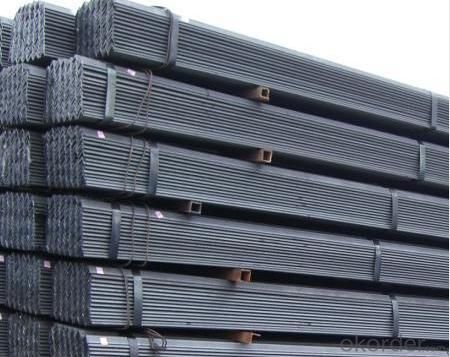
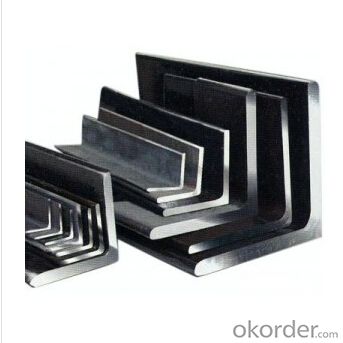
- Q: Can steel angles be used in outdoor or exposed environments?
- Yes, steel angles can be used in outdoor or exposed environments. Steel angles are commonly used in construction and engineering projects and are known for their durability and strength. They are often galvanized or coated with protective finishes to prevent rust and corrosion, making them suitable for outdoor use. Additionally, steel angles can withstand various weather conditions, making them a reliable choice for outdoor or exposed environments.
- Q: What are the different surface finishes available for painted steel angles?
- Painted steel angles offer a range of surface finishes to meet aesthetic and functional needs. 1. Achieving a smooth finish involves evenly applying a coat of paint and then curing it for durability. 2. Textured finishes create a rougher surface with patterns or textures, achieved through techniques like sandblasting or textured paint. These finishes enhance grip and reduce slipperiness in applications requiring traction. 3. Matte finishes have low sheen or gloss levels, resulting in non-reflective surfaces. This option is ideal for applications desiring a subdued appearance. 4. On the other hand, glossy finishes have high sheen or gloss levels, creating reflective and shiny surfaces. They provide a polished and visually appealing look to painted steel angles. 5. Powder-coated finishes are popular for their durability. This method involves coating the steel angle with a dry powder, which is then cured under heat to form a protective layer. Powder-coated finishes offer excellent resistance to scratches, chemicals, and UV rays. 6. Galvanized finishes involve applying a layer of zinc to the steel surface, providing corrosion resistance. While typically not painted, galvanized steel angles can be painted over if desired, allowing for various color options. In summary, painted steel angles offer a variety of finishes including smooth, textured, matte, glossy, powder-coated, and galvanized. The choice depends on the intended use, desired appearance, and required durability for the application.
- Q: Are steel angles suitable for constructing bridges?
- Yes, steel angles are suitable for constructing bridges. Steel angles offer excellent strength, durability, and versatility, making them a popular choice in bridge construction. They can be used to provide structural support, enhance stability, and distribute load effectively, ensuring the bridge's overall integrity and safety.
- Q: Can steel angles be used for fencing?
- Indeed, steel angles possess the potential for fencing. The utilization of steel angles is prevalent in fencing applications owing to their robustness, endurance, and adaptability. They furnish a solid structure for the fence, guaranteeing steadiness and security. The installation of steel angles is a task easily accomplished, and their configuration permits an array of fence designs and heights. Moreover, they exhibit resistance to rust and corrosion, rendering them appropriate for outdoor utilization. In summary, steel angles emerge as a favored option for fencing endeavors due to their structural soundness and enduring effectiveness.
- Q: How do you calculate the moment resistance of a steel angle?
- To calculate the moment resistance of a steel angle, you need to consider the geometry and material properties of the angle. The moment resistance refers to the ability of the angle to withstand bending forces. First, you need to determine the section modulus, which is a measure of the shape's resistance to bending. The section modulus can be calculated by taking the moment of inertia of the angle (I) and dividing it by the distance from the centroid of the shape to the furthest point (c). Next, you need to determine the yield strength of the steel angle. This is the point at which the material starts to deform permanently. The yield strength is typically provided by the manufacturer or can be obtained from material testing. Finally, the moment resistance can be calculated by multiplying the section modulus (Z) by the yield strength (σ). This gives you the maximum moment the steel angle can resist before it starts to deform permanently. Moment Resistance = Z * σ It is important to note that this calculation assumes the steel angle is subjected to pure bending. If there are additional factors such as axial or shear forces, additional calculations or considerations may be required. Additionally, it is always recommended to consult relevant design codes or engineering handbooks for more accurate and detailed calculations.
- Q: What are the different types of steel angles used in staircases?
- Staircases commonly employ various types of steel angles for different purposes. These angles are selected based on the specific needs of the staircase design. 1. The Equal Leg Angle, which forms a 90-degree angle with legs of equal length, is the most frequently used steel angle in staircases. It is typically utilized for structural support within the framework of the staircase. 2. Unequal Leg Angles, as the name implies, have legs of varying lengths. These angles are employed when one side of the staircase requires more support or when a desired aesthetic appearance is desired. They are commonly found in stair treads, risers, and stringers to enhance stability and strength. 3. L-Shaped Angles are utilized in corner connections of staircases. They consist of one straight leg and another leg perpendicular to it, forming an L shape. These angles are often used in stair handrails, balusters, and brackets to provide reinforcement and support at junctions. 4. Slotted Angles are designed with slots along their length, allowing for easy adjustment and flexibility in component positioning. They are frequently employed in adjustable stair brackets, tread supports, and other elements that may require fine-tuning during installation. 5. Flat Bar Angles, also referred to as flat stock angles, are created by bending flat steel bars to form a right angle. These angles are used to provide additional support and reinforcement in staircases that require extra strength. They are commonly found in heavy-duty stair applications or where increased load-bearing capacity is necessary. Ultimately, the appropriate choice of steel angle for a staircase depends on factors such as load capacity, structural requirements, aesthetic considerations, and the specific design of the staircase. Seeking guidance from a structural engineer or staircase designer can assist in determining the most suitable type of steel angle for a particular staircase project.
- Q: What are the environmental impact considerations of using steel angles?
- The use of steel angles in various industries does have environmental impact considerations that need to be taken into account. One major consideration is the extraction and processing of iron ore to produce steel. The mining of iron ore can have significant environmental impacts, including habitat destruction, soil erosion, and water pollution. Additionally, the extraction process requires large amounts of energy, contributing to greenhouse gas emissions and air pollution. Furthermore, the production of steel involves the use of coal and other fossil fuels, which also contribute to greenhouse gas emissions. The burning of these fuels releases carbon dioxide and other pollutants, leading to climate change and air pollution. Steel production also generates a significant amount of waste, including slag and other byproducts. Proper disposal and management of these waste materials are crucial to minimize their impact on the environment. Transportation and logistics also play a role in the environmental impact of using steel angles. The transportation of steel products from manufacturing facilities to construction sites or other end-users can contribute to carbon emissions, especially if long distances are involved. However, it is worth noting that steel is a highly durable material with a long lifespan. This longevity can offset some of the environmental impacts associated with its production and transportation. To minimize the environmental impact of using steel angles, several strategies can be employed. Firstly, using recycled steel reduces the need for extracting new iron ore and decreases energy consumption and emissions. Incorporating recycled content into steel production is an effective way to reduce the environmental footprint. Additionally, improving energy efficiency in steel manufacturing processes can help reduce greenhouse gas emissions. Adopting cleaner technologies, such as electric arc furnaces, can significantly reduce carbon emissions compared to traditional blast furnace methods. Furthermore, sustainable transportation practices, such as utilizing efficient shipping methods or promoting local sourcing, can help reduce the carbon footprint associated with the transportation of steel angles. Overall, while the use of steel angles does have environmental impact considerations, implementing sustainable practices can mitigate these impacts and contribute to a more environmentally friendly industry.
- Q: Can steel angles be used in conveyor belt supports?
- Yes, steel angles can be used in conveyor belt supports. Steel angles provide structural support and stability to conveyor belt systems, making them a common choice for constructing conveyor belt supports.
- Q: 304 what does angle iron stand for?
- 304 is a versatile stainless steel which is widely used in the manufacture of equipment and parts requiring good overall performance (corrosion resistance and formability). 304 stainless steel is a brand of stainless steel produced according to the ASTM standard in the United states. 304 chromium 19%, containing nickel 9%.
- Q: Can steel angles be used for building frames?
- Yes, steel angles can be used for building frames. Steel angles are commonly used in construction for framing applications due to their strength and versatility. They are often used to create the structural framework of buildings, such as in the construction of walls, floors, and roofs. Steel angles provide stability and support to the overall structure and can be easily welded or bolted together to create a strong and durable frame. Additionally, steel angles are available in various sizes and thicknesses, allowing for customization and adaptation to different building requirements. Overall, steel angles are a popular choice for building frames due to their strength, versatility, and ease of use.
Send your message to us
Angle Steel with Material: GB Q235B, Q345B or Equivalent; ASTM A36; EN 10025, S235JR, S355JR; JIS G3192
- Loading Port:
- China main port
- Payment Terms:
- TT or LC
- Min Order Qty:
- 100 m.t.
- Supply Capability:
- 5000 m.t./month
OKorder Service Pledge
OKorder Financial Service
Similar products
Hot products
Hot Searches
Related keywords

